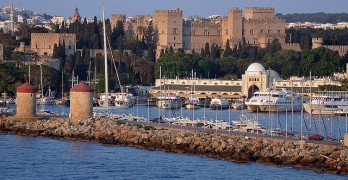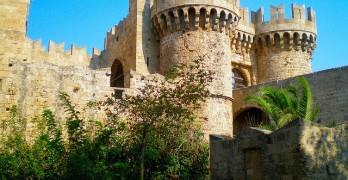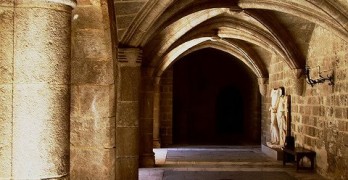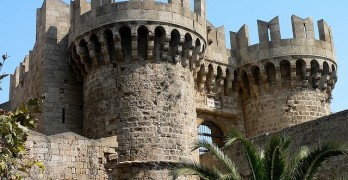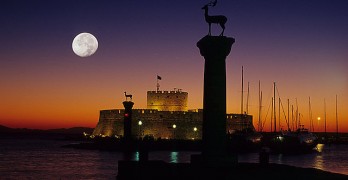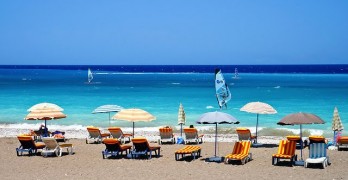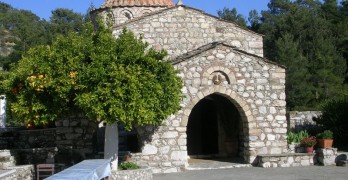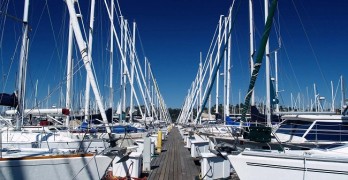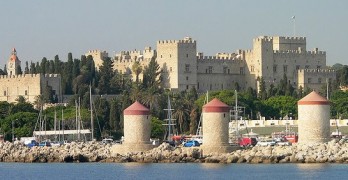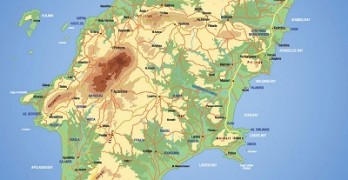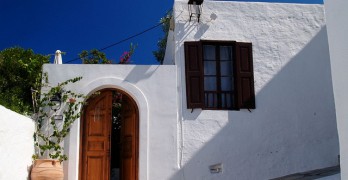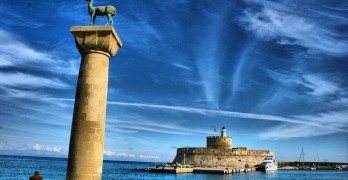 The medieval town of Rhodes (Old Town), is surrounded and defined by big walls which used to protect it and which actually are preserved in very good condition.
The medieval town of Rhodes (Old Town), is surrounded and defined by big walls which used to protect it and which actually are preserved in very good condition.
The walls have a length of some 5 kilometers in total and the fortress is completed with moats, towers and other constructions. The town has seven gates, the most important being the Sea Gate and the Gate d’ Amboise.
The fortress has been well restored and in the interior there are spaces purposely made to facilitate visitors to move around enjoying both an everyday life and receiving several cultural information.
Strolling around in the Medieval Town means to experience history. You will learn a lot, within an environment offering full facilities to the tourist, while at the same time it maintains the atmosphere of the past. The town took the form we know today during the period of the domination of Rhodes by the Knights of the Order of St. John, which lasted from the beginning of the 14th century up to 1522 when Rhodes was conquered by the Ottomans.
The most important monument of the town is the Palace of the Grand Master, the governor of the town and of the island during the medieval times. The palace had been built as early as the 7th century, during the Byzantine period and served as the acropolis of the Byzantine castle. The building is found at the end of Odos Ippoton (Ippoton Street), opposite to the church of Aghios Ioannis (St. John).
During the period of the Knights, the palace was restored and several new buildings were added, in order to cover the services necessary for an administrative building and the residence of the Grand Master. It survived the siege of the Ottomans in 1522 thanks to its perfect construction, but it was destroyed when the neighboring church of Aghios Ioannis suffered an explosion. The Italians restored it in 1940, trying to keep its initial form. A few decades ago, the Greek State carried out extended restoration works, in order to make the place suitable to host the Meeting of the Council of the European Union. Nowadays it houses artistic exhibitions and various cultural events.
The street leading to the Palace of the Grand Master, called «odos Ippoton» (the Knights’ street) is the most important street of the medieval town. 200 meters long and 6 meters wide, the street has at either side the houses of the Knights, whose blazons still survive on the gates of the buildings. Close to the entrance of the street you will see the Knights’ Hospital, the most important building of the period. Today the building houses the Archaeological Museum of the town of Rhodes. At the same street it is found the Church of Holy Trinity, dated in the 15th century.
We could not suggest only one route in the medieval town, the visitor has to visit every square centimetre of it! As you will enter the town from Eleftherias Gate («the Gate of Liberty»), at the northeastern part of the fortress, just beside the commercial port, you will see the ancient temple of Aphrodite (Venus), built in the 3rd century A.D., and, following the stone – paved streets, you will see the Lodging of the Knights of Auverne, dated in the 15th century, the Arms Depot, the Museum of Decorative Arts, the Byzantine Museum and other buildings, until arriving to the «Castello», the Palace of the Grand Master.
Don’t miss to visit the building of «Castellania», which in the past used to be a commercial center, whereas today it houses the Central Public Library, a very important one. You should also see the imposing fountain at Evraion Maryron square (square of «the Martyrs Jews») and remember the prosperous Jewish community which was extinguished by the Nazis, as most of the Jews were moved to the concentration camps and died there. On your way don’t miss to see the Byzantine churches of Aghios Fanourios and Aghios Panteleimon.
In every corner of the medieval town you will find a hidden cultural treasure. At Orpheos street it is found the Clock-Tower, if you walk up there, you will have a panoramic view of the town of Rhodes. Northern to Evraion Maryron square, you will find the Palace of the Admirals, where it was the seat and the residence of the Orthodox Archbishop of Rhodes, during the period of the Knights.The Gate of the Port, or Gate of the Sea, southern to Ippokratous square, has two defensive towers, dominating the port.
At the commercial part of the town, in Socratous street, you will see the mosque of Suleiman, which was built on the place of the Byzantine church of Aghioi Apostoloi (St. Apostles), in honor of the conqueror of the Castle of Rhodes. The mosque is still in use today, as there are many Muslims in Rhodes.
The southern part of the medieval town, the Chora, or Burgo as it was then called, was separated by a wall from the quarter of the Knights, from the Collachium and from the other important buildings of the governors. This part was the quarter of the Greek and the Jew residents of the town. Apart from the other buildings, here you will find several Byzantine and Post-Byzantine churches, as Aghios Panteleimon and Panaghia tis Nikis (the Virgin of the Victory).
Northern to the hospice of Aghia Aikaterini, at the southern part of the town you will see the churches of Aghia Aikaterini (St. Katherine) and Aghia Triada (Holy Trinity), while at the north of the gates of Aghios Athanasios and of Aghios Ioannis (also known as «Kokkini Porta» – the red gate) you will find the churches of Aghios Athanasios, Aghios Fanourios and Aghios Theodoros.
From the period of the Knights it is also worth seeing the Tower of the Angels («Pyrgos ton Angelon»), northern to the building of the Customs, and the foundations of the Tower of Naillac, close to the Gate of Liberty.
Apart from the temple of Aphrodite (Venus), you may also see traces of the wall of the Hellenistic period (at the center and at the East). Left to the port and close to the mosque of Suleiman and to the Ottoman Baths, you may see traces of the wall and the ruins of the defensive towers of the Byzantine period.Ottomans too had left enough buildings to the town: several mosques, baths and other public buildings are preserved from this period.
Even if you are not interested in buildings, but just wish to loaf away, you will be surprised by the medieval atmosphere of the town, which rests intact, despite the crowds of tourists. And, when you stop for a while to relax, think that you are at the same place where some 600-700 years ago, the Knights returning from the Holy Land where doing the same thing at the same place!


